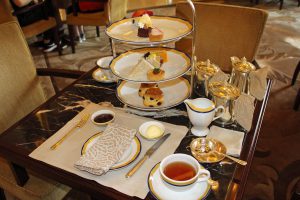MENU
MENU
Chinese and British Tea Culture
The Opium War occurred between the British Empire and the Qing Dynasty of China between 1839 and 1842.
At that time, Britain imported large quantities of tea from Qing and the trade was based on silver. Consequently, a shortage of silver occurred in Britain. Britain attempted to control the outflow of silver by smuggling Indian opium into China. As a result, the number of opium addicts increased and the Qing dynasty cracked down on opium and banned trade with Britain. It led to Britain sending its troops to Qing and war broke out. Britain won the war. Since then, Britain ruled Hong Kong until 1997 when Hong Kong was returned to China.
British tea culture was brought to Hong Kong. Thus, both Chinese and British tea culture can be enjoyed in Hong Kong today.

View from Victoria Peak, in Hong Kong (July 2018)
Yumcha (Dim sum)
Yamucha is a custom of eating dim sum while drinking tea at a restaurant as brunch in Hong Kong and Guangdong Province, China. Dim sum is a small food item, and there are many kinds of dim sum such as shrimp dumplings, spring rolls, rice noodle rolls, sweet cream buns, etc. In a traditional yamucha restaurant in Hong Kong, waiters or waitresses are walking in the restaurant while pushing a trolley with dim sum. Customers call to stop the trolly and select a dim sum they like. There are yam cha restaurants where a customer orders dim sum from the menu.
There are many dim sum restaurants in Hong Kong, where you can have dim sum in the morning or at night.

Yamcha (July 2018)
Afternoon tea
There are hotels in Hong Kong where you can enjoy authentic English-style afternoon tea.
You will be able to spend a memorable and luxurious time at the colonial-style lobby in The Peninsula Hong Kong Hotel.

The Colonial-style lobby in The Peninsula Hong Kong (July 2018)

Afternoon tea at the colonial-style lobby in The Peninsula Hong Kong (July 2018)
Flagstaff House Museum of Tea Ware 茶具文物館
The Flagstaff House Tea and Stationery Museum is located in Hong Kong Park and it takes about 5 minutes on foot from exit C1 of Admiralty (金鐘 Gamjung) station of MRT (Mass Transit Railway) to the museum.

A large teapot object in Hong Kong Park (July 2018)
Flagstaff House was built between 1844 and 1846. It was a residence of the Commander of the British forces in Hong Kong during colonial times and became the Flagstaff House Museum of Tea Ware in 1984.
Most of the tea utensils displayed in the museum were endowed by Dr. Kwee Seong Lo.S. Lo who was an entrepreneur.
In the museum, historically valuable tea utensils made in the Song, Ming and Qing Dynasties are on display. The history of Chinese tea is also displayed.
FragstaffHouseMuseumofTeaWareHongKongPark15-300x186.jpg)
Flagstaff House Museum of Tea Ware 茶具文物館 (July 2018)
There is the LockCha Tea House (楽茶軒) in THE K.S. LO GALLERY (羅桂祥茶藝館) next to the Flagstaff House Museum of TeaWare. You can have dim sum and tea, and buy Chinese tea there, too.

THE K.S. LO GALLERY 羅桂祥茶藝館 (July 2018)

Lock Cha Tea House 楽茶軒 (July 2018)
Tea shops
There are many tea shops in Hong Kong which sell Chinese tea.
Yue Hwa Departmental Store (裕華國產百貨) is located on Nathan Road (彌敦道) which is the main street of Hong Kong. You can buy many varieties of Chinese tea at the tea shops in the Department Store.
YUHAWChineseTeaHall_yuehwa.com13-300x206.jpg)
A tea shop on the 4th floor of in Yue Hwa Departmental Store (July 2018)
Reference:
工藤佳治主編者(2007) 中国茶事典(初版) 勉誠出版
「世界の歴史」編集委員会編(2009)もういちど読む山川世界史(1刷)山川出版社
THE PENINSULA HONG KONG
https://www.peninsula.com/en/hong-kong/5-star-luxury-hotel-kowloon
Flagstaff House Museum of Tea Ware in Hong Kong park フラグスタッフハウス(旗桿屋Flagstaff House)https://hk.art.museum/zh_TW/web/ma/tea-ware.html
*When visiting the shops and facilities introduced in this article, please check the business hours on their website, etc. before visiting.
*The information provided on this site may be updated. If you find any information in this article that is incorrect, new, or incomplete, please contact CHAMART.
*The site does not describe all “Teas of Japan” or all “Teas of the World”. Additionally, each article expresses the writer’s personal experience and feelings.